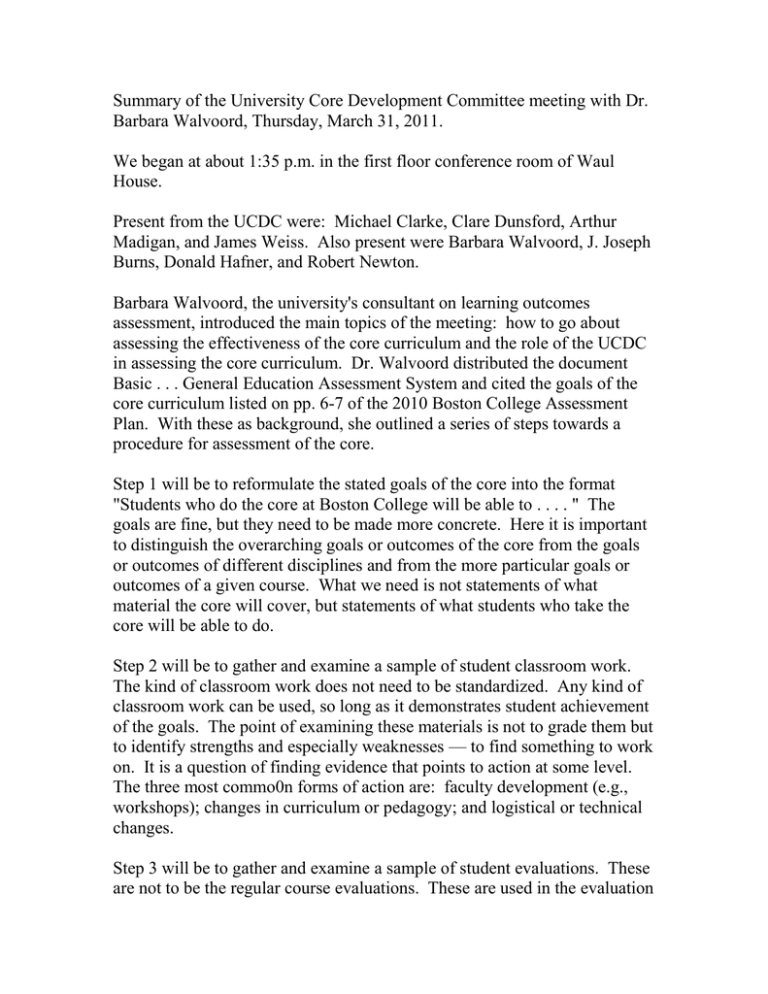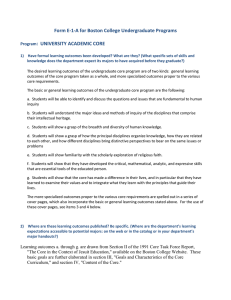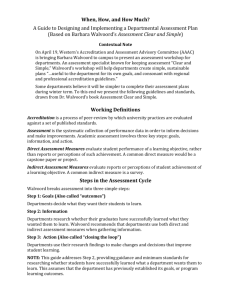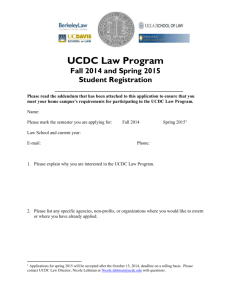Summary of the University Core Development Committee meeting with Dr.
advertisement

Summary of the University Core Development Committee meeting with Dr. Barbara Walvoord, Thursday, March 31, 2011. We began at about 1:35 p.m. in the first floor conference room of Waul House. Present from the UCDC were: Michael Clarke, Clare Dunsford, Arthur Madigan, and James Weiss. Also present were Barbara Walvoord, J. Joseph Burns, Donald Hafner, and Robert Newton. Barbara Walvoord, the university's consultant on learning outcomes assessment, introduced the main topics of the meeting: how to go about assessing the effectiveness of the core curriculum and the role of the UCDC in assessing the core curriculum. Dr. Walvoord distributed the document Basic . . . General Education Assessment System and cited the goals of the core curriculum listed on pp. 6-7 of the 2010 Boston College Assessment Plan. With these as background, she outlined a series of steps towards a procedure for assessment of the core. Step 1 will be to reformulate the stated goals of the core into the format "Students who do the core at Boston College will be able to . . . . " The goals are fine, but they need to be made more concrete. Here it is important to distinguish the overarching goals or outcomes of the core from the goals or outcomes of different disciplines and from the more particular goals or outcomes of a given course. What we need is not statements of what material the core will cover, but statements of what students who take the core will be able to do. Step 2 will be to gather and examine a sample of student classroom work. The kind of classroom work does not need to be standardized. Any kind of classroom work can be used, so long as it demonstrates student achievement of the goals. The point of examining these materials is not to grade them but to identify strengths and especially weaknesses — to find something to work on. It is a question of finding evidence that points to action at some level. The three most commo0n forms of action are: faculty development (e.g., workshops); changes in curriculum or pedagogy; and logistical or technical changes. Step 3 will be to gather and examine a sample of student evaluations. These are not to be the regular course evaluations. These are used in the evaluation 2 of individual faculty, which should be kept separate from assessment. Rather than asking students what they liked, we should focus on the following three questions: how well do they think they have achieved the learning goals of the core? what elements in their core courses helped them and why? and what would have helped them more? / what suggestions do they have? These three questions would form the basis for written evaluations, individual interviews, and focus groups? Step 4 will be to bring student work and student responses together in a forum that will examine them and decide on some action to be taken. Dr. Walvoord said that NEASC will not be satisfied with assessment of individual courses or of disciplines; they will insist on a broader level of assessment. They will insist on assessment of what students are learning in the core program. There needs to be a forum to conduct this broader assessment. Dr. Walvoord saw three possible candidates: the UCDC, a subset or subcommittee of the UCDC, or another committee entirely. Discussion followed. From the discussion it emerged that Dr. Walvoord was not thinking of the UCDC or other body assessing core courses directly; rather she was thinking of the UCDC or other body examining the procedures whereby the various departments assessed the effectiveness of their core courses. Her book Assessment Clear and Simple includes a sample form for departments to report on their learning goals for their core courses, how they will assess the fulfillment of those goals, and what their process is to decide on action in view of the assessment. In this system the departments do the actual reading of student product and student responses and report on it, while the UCDC reads the reports of the departments. Dr. Walvoord reported that NEASC's gold standard would be for a university to review a certain number of core departments each year or, alternatively, to review a certain number of core requirements each year. She suggested that we might consider the LEAP program, details of which are available on the website of the AACU. This provides a statement of learning outcomes that, while written from a secular humanist point of view, may with some tweaking be serviceable for our purposes. Here Robert Newton pointed out that this LEAP statement includes rubrics. Dr. Walvoord then drew a diagram of what the NEASC was looking to see. The first or bottom level of the diagram illustrated the back and forth feedback loops of departments, student work, and student responses. The 3 higher level of the diagram illustrated further levels of contact and feedback between the departments and the UCDC. In conclusion, Dr. Walvoord suggested that we obtain the NSSE and other relevant data from Institutional Research, and that the UCDC see itself as making recommendations to higher levels in the university, as being in a feedback loop with higher levels of decision and budgeting. The meeting adjourned at about 3:00 p.m. Respectfully submitted by Arthur Madigan, S.J.



